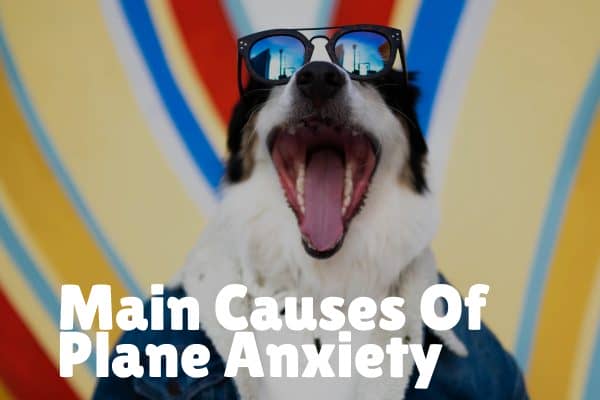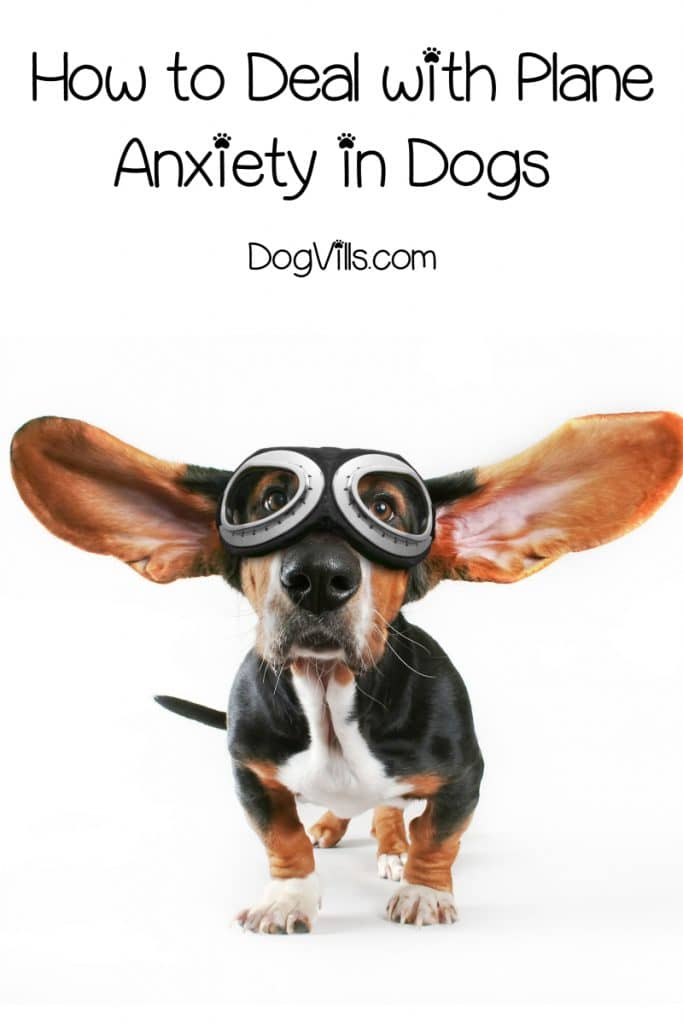It shouldn’t be surprising that plane anxiety in dogs is just as common as in humans.
The airport is a strange place full of odd smells and scary sounds, especially to a dog.
Today, we’ll go over some of the causes behind your dog’s fear of flying.
Then, we’ll discuss some ways that you can help mitigate flight anxiety in your dog.
Let’s get started!
Plane Anxiety in Dogs and How to Deal with It
Plane anxiety is common among the human population.
We’ve all heard news stories over the years about extreme turbulence, plane malfunction, engine malfunction, crashes, and deaths related to flying.
For a portion of the population, those stories or a bad experiences on a plane are enough to induce flight anxiety that can be debilitating.
While our dogs don’t understand news stories and or comprehend the horror stories that humans might speak about in their presence, they can still experience heavy anxiety related to flying.
Today, we’ll go over how flight stresses your dog and how you can help him get through the process of flying with the least amount of stress possible.
Causes of Flight Anxiety in Dogs

Helping your dog navigate through his anxiety first requires that you have an idea of what causes that anxiety.
Dogs can suffer from flight anxiety for a number of reasons just as they can from driving anxiety.
Below are some of the most common stressors that contribute to a fear of flying in dogs.
1. The Initial Trip to the Airport
If your dog suffers from car anxiety, the act of driving to the airport is enough to immediately put him in an anxiety-riddled head space.
By the time a dog with car-related anxiety finally gets to the airport, he’s spooled up like a tightly coiled fear spring ready to pop at any moment.
It’s important to refer back to my previous post and do what you can to get your dog’s fear of car rides under control so that this source of anxiety becomes a non-issue.
2. Strange Sensations
Just like riding in a car, flying in a plane is filled with strange sensations.
The sound of the jet engines, the intercom system, talking passengers, vibrations, and once you’re in the air, turbulence can all lead to severe anxiety in dogs.
These sensations aren’t limited to the plane’s cabin. The process of going through the airport itself is wrought with sounds, smells, and other stimuli that can be tough for a dog to handle.
These sensations work together to give your dog a feeling of being out of control in a scary place with no way out.
3. Negative Experiences
Because of their ability to connect outside stimuli such as commands, hand signals, and clicks with outcomes like praise and treats, dogs respond readily to training.
However, those same connections can have a negative side to them.
If your dog has had a negative experience on a plane such as extreme turbulence or another traumatic event, he will most likely have immediately made the connection between that experience and the process of boarding and/or getting situated on a plane.
Overcoming Flight Anxiety in Dogs

Before I go into any detail of how to overcome flight anxiety in dogs, I want to stress to all readers that you should never fly your dog in the plane’s cargo.
While in cargo, your dog can overheat and die. There have been several cases of dogs and cats dying in transit because of unsafe conditions in the cargo hold.
Unless you have no other option, either fly with your dog in the cabin with you or board him. It’s the safest option.
Now, on to dealing with anxiety related to flying.
Because you won’t exactly be able to ease your dog into flying, we’re going to talk about how you can help mitigate your dog’s anxiety throughout your flight.
The steps to help him deal with flying begin before you even leave for the airport.
*This post contains affiliate links. If you make a purchase through these links, we earn a small commission at no extra charge to you.
1. Getting Used to the Carrier
This is one thing you can do prior to flying to help your dog.
Your dog will be required to be in his carrier at all times throughout the flight, so it’s important to get him used to being in a carrier before you fly.
- Begin by leaving the carrier open in the house so your dog gets used to it being around.
- Put comfy bedding and his favorite toy in the carrier to entice him to enter it.
- After he’s gotten used to the carrier and – hopefully – has actually entered it, it’s time to start training him to be placed in the carrier.
- Lead your dog to the carrier and give him a treat outside of it.
- Then place a treat on the floor in front of the carrier’s opening.
- If all is going smoothly, put a treat just inside the carrier.
- Keep doing this putting treats further and further into the carrier until your dog is eager to enter it.
►►►Check out this video for some more tips on bag-training your dog for travel.
Once you have your dog excited to get into the carrier, partially close the opening while still giving him treats.
Keep doing this, closing the carrier more and more each time until he is comfortable with being in the carrier.
The final step is to get him used to being in the carrier for an extended period of time.
- Get him in the carrier, close it up, and then leave him in it for about 5 or 10 minutes then give him a treat.
- Continue to give him a treat every 5 or 10 minutes as long as he seems comfortable.
- If at any point, he seems agitated, immediately let him out of the carrier.
- Continue in this way until you’ve gotten him up to half an hour or an hour in the carrier.
After you’ve gotten that far, begin to space his treats further apart to about 15 minutes.
Continue giving treats ever 15 minutes while extending the overall time he’s in the carrier.
Eventually, you’ll want to reach a place where you can give him a treat about every half an hour and keep him in the carrier for several hours at a time.
Do this on a weekend when you can clear your schedule.
2. Make His Carrier Familiar
The day before you leave for your flight, wear a t-shirt so you can get your scent on it.
Just wearing it is fine. Don’t go to the gym and get it all sweaty. You just want it to smell like you.
On the day of the flight, place that shirt in the bottom of the carrier so that your scent surrounds him throughout the entire flight.
3. Don’t Feed a Full Meal
This is recommended for three reasons. First, you don’t want your dog to have to go potty on the plane.
Second, if your dog is prone to motion sickness, he could throw up if he has a belly full of food.
Third, you want your dog to be primed to accept his favorite treats as you fly to help keep him calm. And speaking of that…
4. Bring Plenty of His Favorite Treats
Be sure to bring plenty of your dog’s favorite treats along with you to help ease his flight anxiety.
When the time comes to slide the carrier under your seat, give your dog a treat.
Give him a treat periodically throughout the flight as well, while you scratch his head. You should be able to open the carrier just enough to get your hand in there.
Lots of scratches and treats can help keep him calm or at least calm enough to get through with relatively little trauma.
►►►Here’s a great video with some tips on what to pack when traveling with your dog:
https://www.youtube.com/watch?v=OHBGqKWW_dk
5. Adaptil Collar and Spray
We used this at the vet all the time when I worked there. Adaptil is a product containing calming dog hormones.
It comes in both spray and collar form, and I highly recommend the use of both. The night before the flight put an Adaptil collar on your pet.
The day of the flight, spray the carrier with the spray. I recommend this to help ease your dog’s tensions or to head them off before they start if your dog is normally a laid back guy.
Sedatives
When all else fails, or if your dog is so high strung on a regular basis that no amount of training or treats will help, ask your vet about sedatives.
Depending on your dog’s level of anxiety and personality in general, your vet might recommend anything from a light dosage of a gentle sedative to promote calmness to a tranquilizer to actually make your dog go to sleep.
This might seem mean to some owners, but the alternative is either having your dog a nervous wreck on the flight, transporting him in cargo (which you should never do), or leaving him at home.
It’s also important to remember that your vet knows your dog’s entire medical history so prescribing him a sedative should be extremely safe.
When I worked at the vet, we frequently prescribed sedatives for nervous travelers and for those pooches who freaked out at the vet. In my 7 years, we never once had an issue.
Flight Anxiety Can be Controlled with a Little Effort
Between training, treats, and creating a carrier that feels like a haven rather than a punishment, you can help eliminate or at least mitigate flight anxiety in your dog.
Start training your dog to enjoy his carrier as soon as possible so he has plenty of time to get used to it. It’s also important to know your dog.
If your dog is one of those fidgety, vibrating, nervous Nelly little guys, the kindest thing might be to ask your vet about a sedative for the flight.
Whatever you choose, if you take the time and do your due diligence, you should be able to help your dog with his flight anxiety. So good luck and happy flying.
Have you ever dealt with plane anxiety in dogs? Share your tips and experiences below!
Author
-

A former Veterinary Assistant at Southwest Animal Care Hospital, Ben is an animal lover, blogger, and all-around geek. Along with writing for DogVills, Ben runs his own virtual assistant company, BizzyBim.
View all posts




